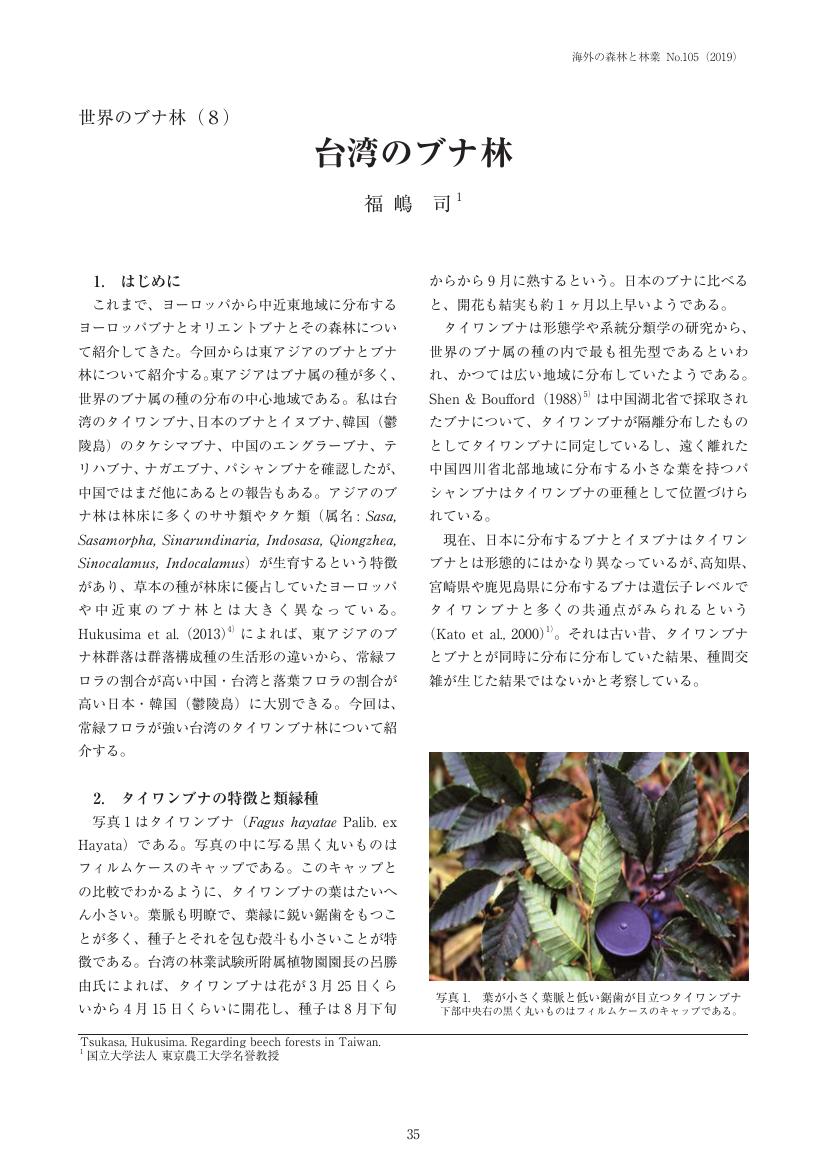12 0 0 0 OA 世界のブナ林(8) 台湾のブナ林
- 著者
- 福嶋 司
- 出版者
- 公益財団法人 国際緑化推進センター
- 雑誌
- 海外の森林と林業 (ISSN:18826261)
- 巻号頁・発行日
- vol.105, pp.35, 2019-07-01 (Released:2019-09-27)
- 参考文献数
- 5
3 0 0 0 OA 森林を利用した都市防災計画
- 著者
- 福嶋 司
- 出版者
- 日本森林学会
- 雑誌
- 森林科学 (ISSN:09171908)
- 巻号頁・発行日
- vol.17, pp.2-7, 1996-06-01 (Released:2017-07-31)
2 0 0 0 OA 日本のブナ林群落の植物社会学的新体系
- 著者
- 福嶋 司 高砂 裕之 松井 哲哉 西尾 孝佳 喜屋武 豊 常富 豊
- 出版者
- 日本生態学会
- 雑誌
- 日本生態学会誌 (ISSN:00215007)
- 巻号頁・発行日
- vol.45, no.2, pp.79-98, 1995
- 被引用文献数
- 46
Phytosociological classifications were carried out in order to revise and coordinate data on beech forest in Japan. Reports from different authors as well as our investigations using the BRAUN-BLANQUET method resulted in a total of 2,717 releves. These were used for constructing a vegetation table that produced five beech forest associations. These associations are 1. Sapio Japonici-Fagetum crenatae, 2. Corno-Fagetum crenatae, 3. Sasamorpho-Fagetum crenatae, 4. Lindero umbellatae-Fagetum crenatae and 5. Saso kurilensis-Fagetum crenatae. Associations 1,2,and 3 belong to the alliance, Sasamorpho-Fagion crenatae, which is distributed along the Pacific coast of Japan, whereas 4 and 5 belong to the alliance Saso-Fagion crenatae, which is distributed along the Japan Sea side. These alliances are of the order Saso-Fagetalia and of the class Fagetea crenatae. On the Pacific side, there are more floristic variations because there are many independent mountains with their own characteristic floras. Association 1 is distributed mainly on Kyushu, Shikoku and Kii peninsula. It is characterized by the Sohayaki elements which are historically related to that of East Asia. Association 2 is distributed mainly in the Fuji Volcanic Area whose characteristic features are the Fossa Magna elements. Association 3 is distributed mainly from the Chubu to Kanto regions inland with an extension into the middlepart of Tohoku. Its floristic composition represents the typical Pacific side beech forests. Along the Japan Sea side, there are fewer floristic variations because the covered area is more extensive and has a wider altitudinal range, with heavy snow deposition. Association 4 is distributed from Chugoku up to the low altitudinal areas of Hokuriku. Its floristic composition is basically made up of the Japan Sea elements with some Pacific side flora. Association 5 is distributed from Hokuriku through Tohoku, up to southwest Hokkaido, and floristically this is typical of the Japan Sea side.
1 0 0 0 OA 世界のブナ林(3) イタリアのブナとブナ林 1
- 著者
- 福嶋 司
- 出版者
- 公益財団法人 国際緑化推進センター
- 雑誌
- 海外の森林と林業 (ISSN:18826261)
- 巻号頁・発行日
- vol.100, pp.47, 2017-12-01 (Released:2019-07-04)
- 参考文献数
- 1


